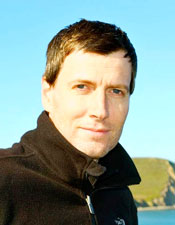July 24, 2013
A Thought Leader Series Piece
Note: Chris Spence is the director of the Institute at the Golden Gate, a program of the Golden Gate National Parks Conservancy in partnership with the National Park Service that advances environmental stewardship and well-being through parks and public lands.
Do you ever feel like the news on climate change is stuck on repeat? Day after day and year after year, we seem to hear the same dire predictions from climate scientists and activists, the same calls to "act now before it’s too late!"
I first started working on climate policy in 1993, which coincidentally is the year the movie "Groundhog Day" first screened. It’s about a selfish television weatherman doomed to repeat the same day time and again until he finally learns to change his ways.
Over the past 20 years, I’ve sometimes felt like I’m stuck in "Groundhog Day." While the science is stronger than ever, working on climate policy can feel like being trapped in a time warp of inaction and paralysis. We all know the problem is real and growing, but serious action on a large scale sometimes seems beyond our grasp.
Who can lead us out of this?
Back in the 1990s, I thought it might be our political leaders. The United Nations (UN) was leading the way through the newly minted Framework Convention on Climate Change and Kyoto Protocol. Having attended more than my share of UN climate negotiations, I can vividly recall the palpable sense of excitement among the thousands of diplomats and other participants who attended some of the early meetings. Freshly inked, the UN agreements had the vocal support of high profile leaders like Al Gore and Tony Blair. What could possibly go wrong?
Fast forward a few years and the mood had shifted. By the early 2000s, the UN process felt like it was losing its way. For several years, I led teams of experts who attended these meetings on behalf of the International Institute for Sustainable Development (IISD). IISD has a marvelous publication—the "Earth Negotiations Bulletin"—which it publishes from UN events. The "Bulletin" provides detailed news and analysis each day on the state of play, including countries’ negotiating positions and strategies. It’s a non-partisan service providing much-needed transparency—and hopefully some accountability—on why meetings either succeed or fail.
As the years went by, the number of failures began to outweigh the successes. I recall a particularly dismal conference where I went looking to interview one of the prominent European politicians to get their perspective. By chance, I passed two of these VIPs in less than five minutes. First, Britain’s Deputy Prime Minister trudged by, head bowed and alone, not an adviser in sight. Moments later, I spied a prominent European environment minister sitting in his office at the conference center, head in his hands. Both looked so downcast, I didn’t have the heart to speak with them.
The power of small, local change
Clearly, the UN process is still struggling. However, I still believe that all countries can work together and I would never give up hope that the UN can lead again. But for now, it’s clear we cannot depend on a top-down approach. The same goes for our national leaders; around the globe, there are strong forces aligned against political action. Policy victories from our world’s capitals are few and far between.
In spite of the vacuum in global and national leadership, we can take heart from the multitude of local and regional initiatives that have blossomed in recent years. Regional and local governments, individual cities and states, as well as neighborhoods, communities, and schools, are all leading bottom-up movements for change. There are also many nonprofit organizations, think tanks, companies, and entrepreneurs who are genuinely and seriously engaged. We can feel inspired by such energy, and should be finding ways to support and scale up such activities.
Parks pointing the way
An example from my own field illustrates the point. Last year, I joined the Institute at the Golden Gate, a California-based nonprofit committed to making parks and protected areas part of the solution to broader societal challenges. One of our programs is focused on using parks to engage the public on climate change. In our latest report published in May, we identified examples of innovative, effective, and powerful educational programs in 13 parks around the world. During the course of our research, we identified many more parks where the public were being informed about climate change in a compelling, empowering way.
Parks are on the frontline of climate change. Park rangers and other staff members are a trusted and respected source of information. What better place could there be for the public to be informed and inspired on this critical issue? While some visitors are already learning from our parks, an even larger number could benefit. With 283 million visitors to U.S. national parks alone, we believe there’s an opportunity to scale up and increase the impact.
If we can learn to champion and replicate local success stories, I believe we can turn that "Groundhog Day" feeling of paralysis and inaction into a thing of the past. We can amend the climate change narrative for good.
About the author: A native of England, Chris Spence brings 20 years of experience working internationally and in the United States on sustainable development, including conservation, climate change, health policy, and protected areas. Prior to joining the Institute at the Golden Gate in 2012, he served in senior management roles for nonprofits in New York, Europe, and New Zealand. He has also consulted for the United Nations and IUCN, the World Conservation Union. Spence is an award-winning writer who has been widely published and has been a guest speaker at many international events.


